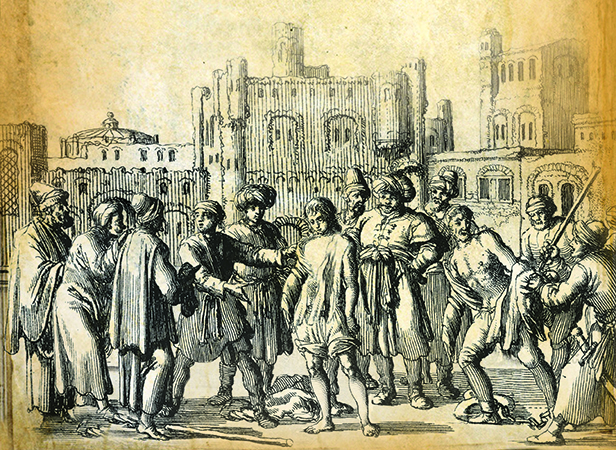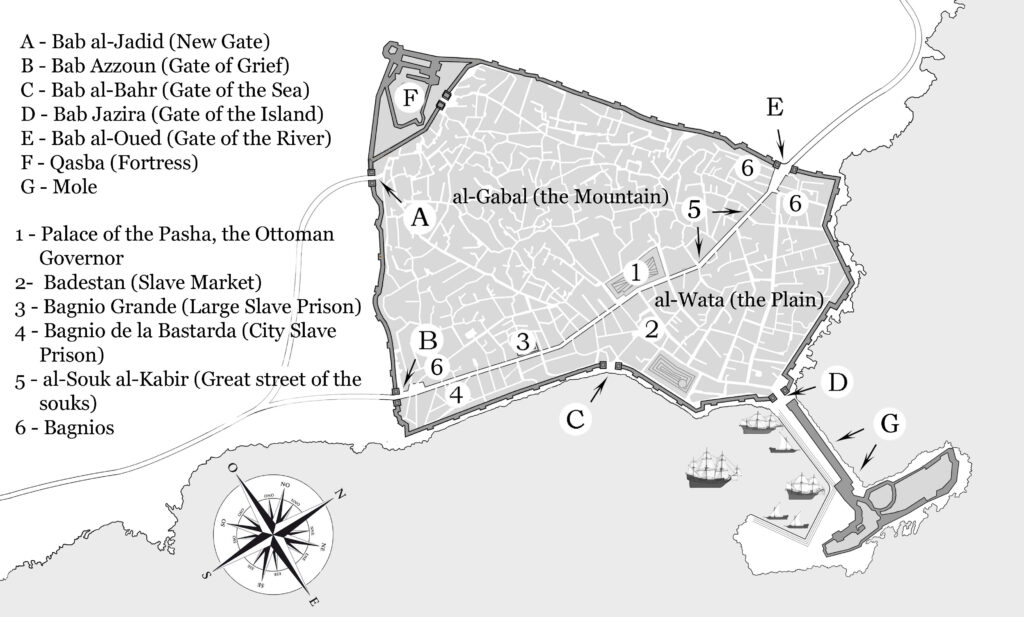This week we continue the series of posts about Algiers, describing what the experience would have been like for European captives who were brought into the city. Last week, we looked at the process by which the Pasha (the Ottoman Governor of Algiers) selected the captives that he was officially entitled to. This week, we look at how captives were auctioned off into slavery—an event that took place in a market known as the Badestan.
The word “Badestan” is a European rendering of the Ottoman Turkish word “Bezistân” (from “bez,” meaning canvas or cloth, and “stân,” the familiar suffix used to indicate place). The word was used generally throughout the Middle East to refer to a covered market—also referred to as a souk in Arabic.
Every Ottoman city of any size had its Bezistân. Generally, a city’s Bezistân was the place where expensive, precious, or luxury items were sold (there were separate markets for more pedestrian commodities such as livestock, grains, fruits, cloth, leather goods, household objects, etc.). So the Algiers Badestan might have been the place where slaves were sold, but it was not dedicated solely to that purpose. Other commodities were sold there as well, including the merchandise from captured European ships.
The most famous Bezistân was in Istanbul. The Badestan in Algiers was no doubt similar to it, both in function and form, since there was a certain generic commonality to such covered markets. Nicolas de Nicolay, who traveled to Istanbul in the early 1550s as a member of an embassy from the French King Henry II to the Ottoman Sultan Suleiman the Magnificent, visited the Istanbul Bezistân and left us this description:
The place called the Bezistân is large, square, and high. It is constructed as a covered hall, with four gates and laneways within it, with shops lining it furnished with all sorts of rare and expensive merchandise such as rings, precious stones, furs of martins, sables, wolves, deer, foxes, and others… all sorts of cloth of gold, of silver, of silk…Turkish bows, targets and bucklers, and other merchandise very rich and opulent.
There are also sold there, to those who bid the most for them, an infinite number of Christian slaves of all ages and both sexes. They are sold as we sell horses, for those who wish to buy these slaves view their eyes, their teeth, and the whole of their body, and even cause them to be stripped naked and watch them move about so that the buyers might better know the defects of nature that might be in them or the imperfections of their persons, a thing most pitiful and lamentable to behold.
I saw there a Hungarian girl of thirteen or fourteen years of age, who, in one of the corners of the Bezistân, was stripped and examined three times in less than an hour, and who, in the end, was sold and delivered to an old Turkish merchant for the sum of thirty-four ducats.[1]
The Algiers Badestan was likely the same sort of place as the one in Istanbul, and the above description probably fits it quite well: a walled-in rectangular space filled with shops selling all manner of goods—including human beings.
Laurent d’Arvieux, who was the French Consul in Algiers in the 1670s, described the Badestan as “a long and wide street, closed at both ends, where everything from the prizes the corsairs bring in is sold.”[2] Cornelis Pijnacker, a Dutch Special Envoy who was in Algiers in the 1620s, visited the Badestan. Pijnacker provided no descriptive detail, but he did provide dimensions: “It is a square, not very big, and longer than wide, about eighty or a hundred feet long and half that wide.”[3]
It is not altogether clear what kind of “foot” Pijnacker had in mind, but it was probably the Amsterdam foot, a unit of length commonly used during this period, estimated at 28.3 centimeters. By this measurement, the Badestan would have been about 70 – 90 feet (22 to 28 meters) long and 35- 45 feet (11 to 14 meters wide).
Putting the details from these various sources together, we can come up with a composite description of the Algiers Badestan: it was an enclosed rectangular space, likely at least partially covered over, close to 90 feet (28 meters) long by about 45 feet (14 meters) wide, lined with shops on all sides. There were far more things being sold there than just human beings, and it would have been a crowded, noisy, bustling place.
The Badestan was located only a little over 300 feet (100 meters) from the Dar es-Sultan, the Palace of the Pasha, the Ottoman Governor of Algiers. (See the map of Algiers below.)
Selling human beings took time, though, so captives newly dismissed after the Pasha had made his choices would not have simply been hustled off in a group straight to the Badestan. Instead, they were housed in various locations while, one by one, they were auctioned off.
Father Dan, a French Trinitarian friar who was in Algiers on a ransom expedition in the summer of 1634, witnessed firsthand the sale of slaves. Here is his description:
Recently taken captives are brought out of the prison where they are kept under guard and brought to the Badestan, along with the Rais, or Captain, of the vessel that has captured them, and other officers deputized expressly in order to ascertain how much the captives will be sold for.
There are brokers, like horse dealers, who, well versed in this business, walk beside the captives the length of the market, loudly shouting that they are for sale to whoever wants to buy them. This I have seen multiple times, with so much unhappiness that I must confess I had tears in my eyes and my heart went cold.
The buyers carefully scrutinize these poor Christian captives, whom they strip naked as they like, without regard for their shame. No matter what, the captives must obey every command immediately, or be struck with truncheons, which these inhuman people are always quick to use. The buyers look to see if the captives are strong or weak, healthy or sick, or if they have any wound, or some disease that can prevent them from working.
After this, using blows of their truncheons, the buyers make the captives walk, jump, and cavort about in order to determine how healthy they are. The buyers also look at the captives’ teeth, not to know their age, but to see if they have tooth decay, which would make them less valuable. In addition, they look into the captives’ eyes and study their faces in an effort to divine their natures, whether good or bad. [4]
For the next installment of this series of posts on Algiers, see the next post here in this blog.
____________________
[1] Nicolas De Nicolay, Les navigations, peregrinations et voyages faits en la Turquie par Nicolas De Nicolay (Navigations, Peregrinations, and Voyages made in Turkey by Nicolas de Nicolay), originally published in 1577, p. 114.
[2] Laurent d’Arvieux, Mémoires du chevalier d’Arvieux, tome 5, (Memoirs of the Chevalier d’Arvieux, Volume 5), originally published in 1735, p. 266.
[3] Historysch verhael van den steden Thunes, Alger ende andere steden en Barbarien gelegen, originally written in 1627, ed. G. S. van Krieken, p. 72. The word “schoen” should be understood as meaning “feet.”
[4] Pierre Dan, Histoire de Barbarie et de ses corsaires, des royaumes, et des villes d’Alger, de Tunis, de Salé et de Tripoly, seconde édition, originally published in 1649, p. 392.
 The Travels of Reverend Ólafur Egilsson
The Travels of Reverend Ólafur Egilsson
The story of the Barbary corsair raid on Iceland in 1627
Amazon listing
